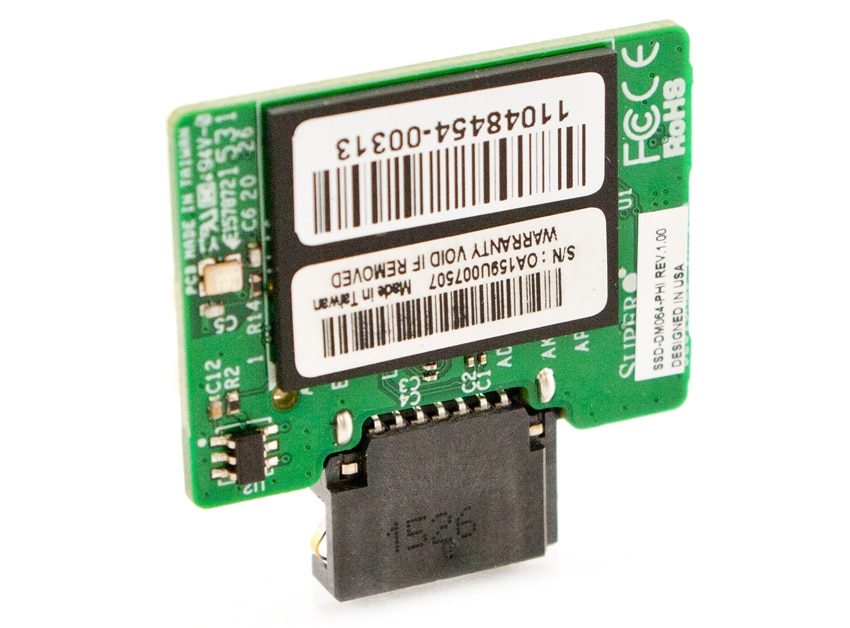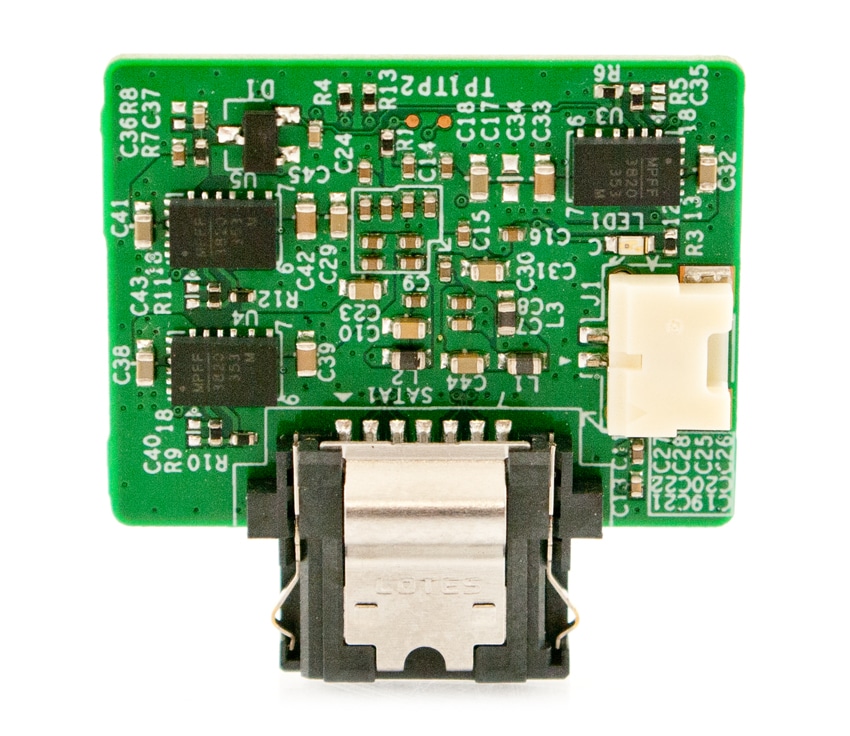 The SATADOM has been a popular way of leveraging a small amount of flash to get a boot image onto a server without burning one of the more valuable drive bays. For many OS images or hypervisors, the concept works perfectly well, some users can even get away with an SD card for such purposes. The SATADOM has several benefits though, including higher quality NAND and performance that far outstrips a memory card. Supermicro calls their effort in this space a SuperDOM, largely because the performance profile is higher than what traditional SATADOMs have offered; it's more along the lines of a standard SSD. The Supermicro SuperDOM uses a SATA 6Gb/s interface to connect directly to the server board and comes in capacities up to 128GB. The SuperDOM supports both X9 and X10 boards and uses only 1-2 watts.
The SATADOM has been a popular way of leveraging a small amount of flash to get a boot image onto a server without burning one of the more valuable drive bays. For many OS images or hypervisors, the concept works perfectly well, some users can even get away with an SD card for such purposes. The SATADOM has several benefits though, including higher quality NAND and performance that far outstrips a memory card. Supermicro calls their effort in this space a SuperDOM, largely because the performance profile is higher than what traditional SATADOMs have offered; it's more along the lines of a standard SSD. The Supermicro SuperDOM uses a SATA 6Gb/s interface to connect directly to the server board and comes in capacities up to 128GB. The SuperDOM supports both X9 and X10 boards and uses only 1-2 watts.
The SATADOM has been a popular way of leveraging a small amount of flash to get a boot image onto a server without burning one of the more valuable drive bays. For many OS images or hypervisors, the concept works perfectly well, some users can even get away with an SD card for such purposes. The SATADOM has several benefits though, including higher quality NAND and performance that far outstrips a memory card. Supermicro calls their effort in this space a SuperDOM, largely because the performance profile is higher than what traditional SATADOMs have offered; it's more along the lines of a standard SSD. The Supermicro SuperDOM uses a SATA 6Gb/s interface to connect directly to the server board and comes in capacities up to 128GB. The SuperDOM supports both X9 and X10 boards and uses only 1-2 watts.

While the SuperDOM offers an impressive performance profile for a product in this category (520MB/s read, 180MB/s write), it's important to understand where the DOM makes the most sense. As can be seen from the performance profile, the tasks should be largely read oriented. This means acting as a boot drive, recovery drive, license drive or as an installation source. The SuperDOM really shouldn't make its way into any scenario where read/write performance is paramount, or in a use case where there's more than 1 drive write per day.
Supermicro SuperDOM Specifications
- Capacity
- 16GB, 32GB, 64GB, 128GB
- Performance
- Max Sequential Read/Write
- 16GB – 285/75MB/s
- 32GB – 520/145MB/s
- 64GB – 520/180MB/s
- 128GB – 520/180MB/s
- Power Consumption
- Typical Read (W): 1.0 (16GB), 1.4 (32GB, 64GB, 128GB)
- Typical Write (W): 0.9 (16GB), 1.2 (32GB), 1.6 (64GB, 128GB)
- Drive Write Per Day (DWPD): 1
- Endurance (TBW):
- 16GB – 17
- 32GB – 34
- 64GB – 68
- 128GB – 158
- Max Sequential Read/Write
Design
The SuperDOM is very small and easily comparable to the size of USB thumbdrives. There's very little to the device and installation is a simple click into place to install. X10 boards with the yellow connector do not require additional power. X9 boards with the white connector do require a 5W plug be installed to power the unit.

One side of the DOM contains the NAND package, where the reverse holds the other circuitry as well as the optional power connector for boards that can't supply the required voltage through the SATA port.
Performance
The SuperDOM is designed for environments that demand strong read speed, but might not have as much concern around write performance. This is all relative of course, when boot options in this category include SD flash cards and USB thumbdrives. While write or random performance isn't critical for most use cases where the SuperDOM may be deployed, more is almost always better. We measured the performance of the SuperDOM in our Supermicro SuperServer 1028U-TNR4T+.
In our 2MB sequential read workload we measured a peak transfer speed of 479MB/s, with sequential write speeds coming in at 217MB/s. This easily tops what 7K, 10K or 15K HDDs can offer, as well as entry-level flash products (SD, USB). Turning our focus to random large-block workloads, we saw a read speed of 457MB/s and write speed of 193MB/s. Still very respectable for a boot device. Our last test looks at random I/O with 4K transfers at 1QD, where the SuperDOM measured 9,505 IOPS read and 10,190 IOPS write. For a single chip flash product these speeds were fantastic and actually above our expectations.
Conclusion
The Supermicro SuperDOM fills a gap where the user desires very good read-centric performance but doesn't want to give up a drive slot just to boot a server. Common tools like USB drives and SD cards often fill this duty today, but both have limitations and can't come close to hitting the sequential or random performance we saw with the SuperDOM. Further, all recent Supermicro server boards support the SuperDOM and installation is a simple clicking of the drive into place. Lastly, the units are pretty cost competitive too, the 64GB DOM in this review comes in at roughly $80-90 plus the added value of not consuming a drive bay. We figure many will find that a small price to pay for the near-SSD performance the SuperDOM offers in conjunction with all of the other benefits DOMs enable.
Supermicro SuperDOM Product Page
Sign up for the StorageReview newsletter
